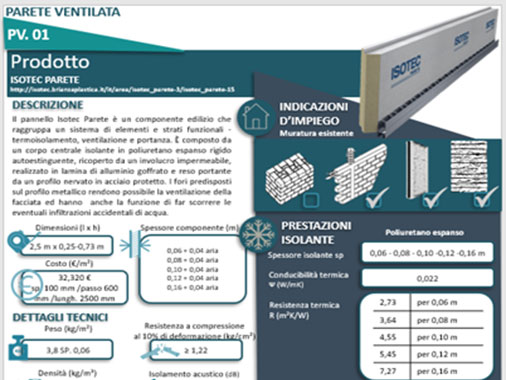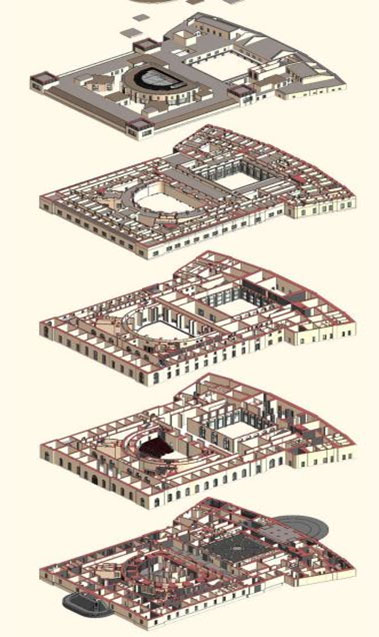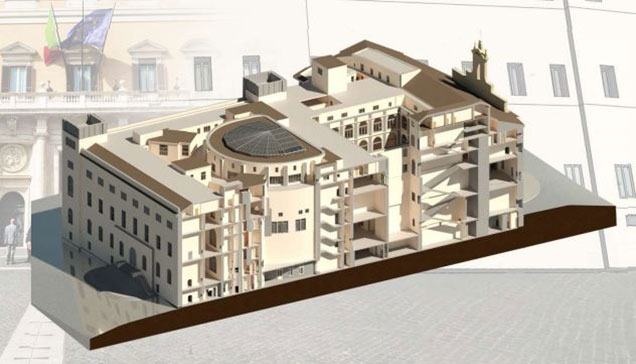Ongoing researches zh
Energy efficiency of industrial product and process
The research activity within the WP2 "Improving the energy efficiency of production processes and management of the built", carried out by CITERA, is aimed at the development of an abacus casing of standardized modules as the basis of an industrial production process, for Deep Renovation of the national residential building stock.
The first year covers a search on the state of technological solutions to existing building envelope as a basis for interventions Deep Renovation of Real Estate in the housing sector.
a survey of the main construction methods of the national residential building heritage was carried out, articulating the classification according to the climatic and seismic areas, the time of construction and the state of conservation. was therefore developed an abacus consists of sheets of opaque building envelope packets representative of the national residential building stock, depending on the period of greater spread, to catalogue the main cases and be able to identify the relative specific solutions to be adopted so that they are compatible with the above context.
It will be elaborated a catalogue of standardized solutions with the highest performance modules for improve the efficiency outside the building envelope with coat systems or ventilated wall, from the inside to buildings with facades and constrained through the complete replacement of the infill. Document there will be tabs for each performance module with the technical data and those resulting from performance simulations in winter and summer conditions; the comparison between the performance of various products applied on the same type of opaque vertical closing, allow to identify the best solution for each, for each climatic and seismic zone. During the last annuity will proceed with the execution of simulations of the performance of the best performing modules identified, through the application of a demonstrator stand-alone.

Digital Twin of Palazzo Montecitorio and Other Main Building Of Lazio Region
Under two separate agreements on CITERA it created the digital model of Palazzo Montecitorio, the seat of the Chamber of Deputies, and for the region of Lazio palace headquarters of the Civil Defense in via Laurentina, and is building modeling headquarters of the Lazio Region via Cristoforo Colombo, together with the creation of an archive


Upcycle of municipality waste as construction components
The issues of environmental sustainability have for years been at the centre of various initiatives, especially of the European Union, which promotes the search for solutions to preserve resources for future generations. The production of waste and the exploitation of raw materials are the main factors that still make the construction sector less environmentally friendly.
The construction sector is, in fact, responsible for the production of over 57 million tons of waste according to the latest ISPRA report, contributing 41% of the total product.
Directive 2008/98/EC foresees a target of 70% recycling of construction and demolition waste by 2020 to reduce the environmental impacts associated with landfilling.
CITERA carries out a research activity to verify how certain waste materials produced by the construction sector but also by the urban sector (such as rubber, cardboard, plastic, glass, wood), can be converted into innovative and high-performance buffering building components that meet the requirements of environmental sustainability.
The development and demonstration of technological solutions based on the reuse and upcycling of waste, the promotion of eco-innovative solutions and their testing in real environments, will improve the market uptake of such systems and contribute to sustainable global urbanization in line with the objectives of the circular economy.
For each new building component designed based on the waste upcycle, the thermal performance in winter and summer, the sound insulation capacity (the Weighted Acoustic Attenuation Index) and the economic costs (parametric cost) will be studied. The components will be designed to achieve thermal performance in compliance with the limit values set by current regulations, also considering the dimensions to facilitate maneuverability on site.
Age friendly building labelling
has been developed by CITERA an age-friendly certification system to assess the level of adequacy of housing, urban and social context in which an elderly person lives. The research has been developed through three main phases:
1- a cognitive phase based on interviews and surveys directly addressed to the elderly, but also to professionals and operators involved in the sector, to identify the needs most felt by the over 65s and the key aspects that determine their level of well-being;
2- a phase of reconnaissance of the international state of the art aimed at identifying the characteristics and equipment of the urban context and the living spaces in which the life of the elderly takes place to increase its quality (this phase was completed with the administration of questionnaires addressed to the elderly and interviews with stakeholders);
3- a phase of selection of national and international best practices as a support for the selection of Italian case studies and as a reference for the development of age-friendly strategies.
The proposed solution is, therefore, the result of participatory planning that aims to improve the quality of life of the elderly, offering a tool for objective evaluation and certification of buildings, places and social contexts suitable for them. The age-friendly certification evaluates separately the three dimensions (building, urban environment, social context) assigning a score that corresponds to a specific level of performance: bronze, silver, gold.
For each dimension, macro-areas have been identified within which the categories that deal with particular aspects are collected and for each of them the criteria that constitute the real evaluation items.
The performance levels are assigned to housing after being evaluated according to 35 different criteria, to the urban environment through 24 criteria and to the social sphere through 12.
The implementation of the certification provides a snapshot of the current housing, the urban context and the social context in which it is located; this is a fundamental starting point for identifying the improvement measures to guarantee at least the minimum requirements that emerged from interviews with the over-65s and experts in the field.
